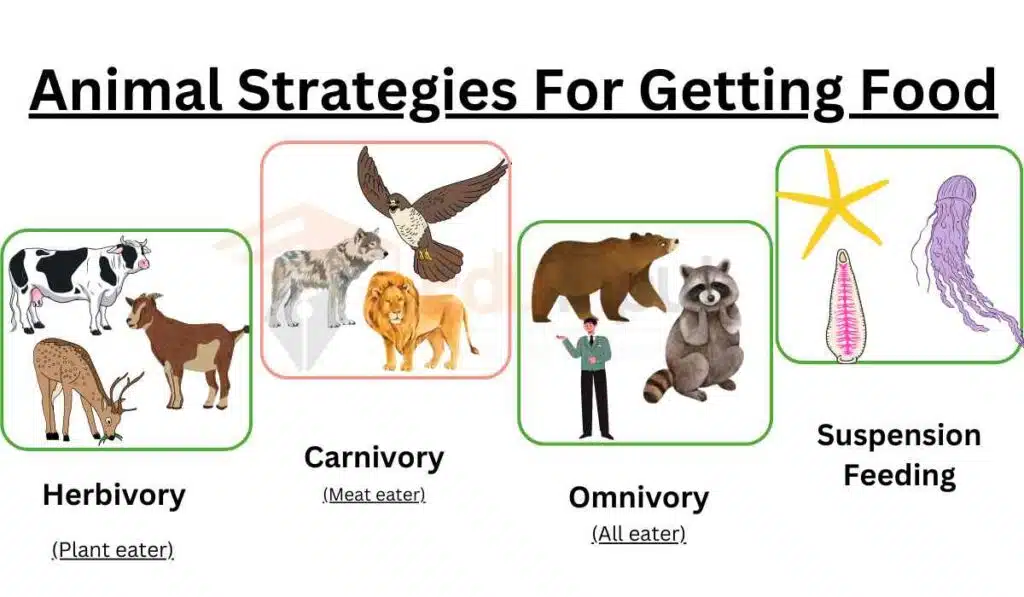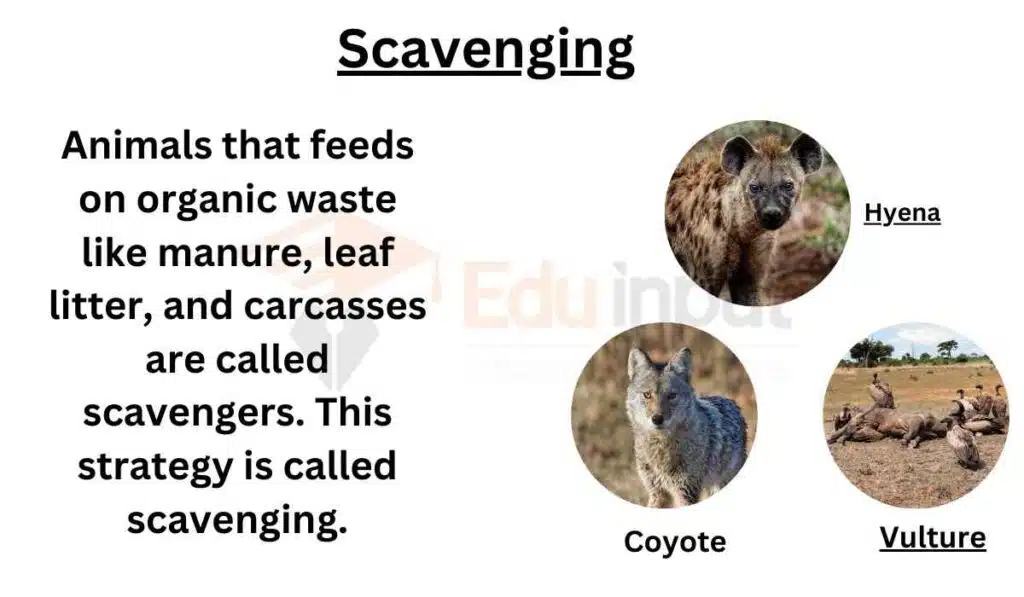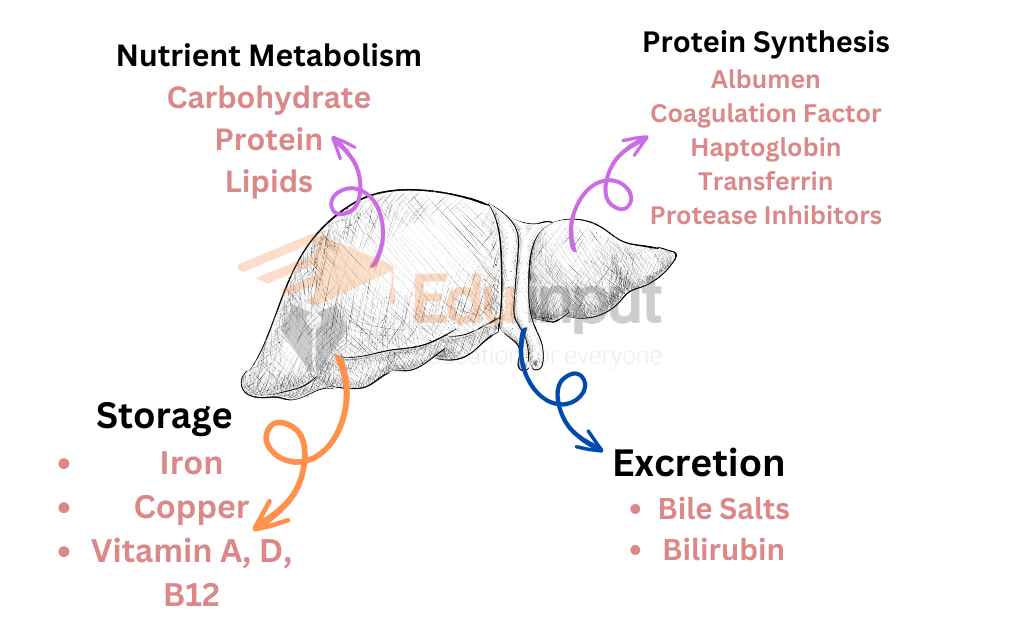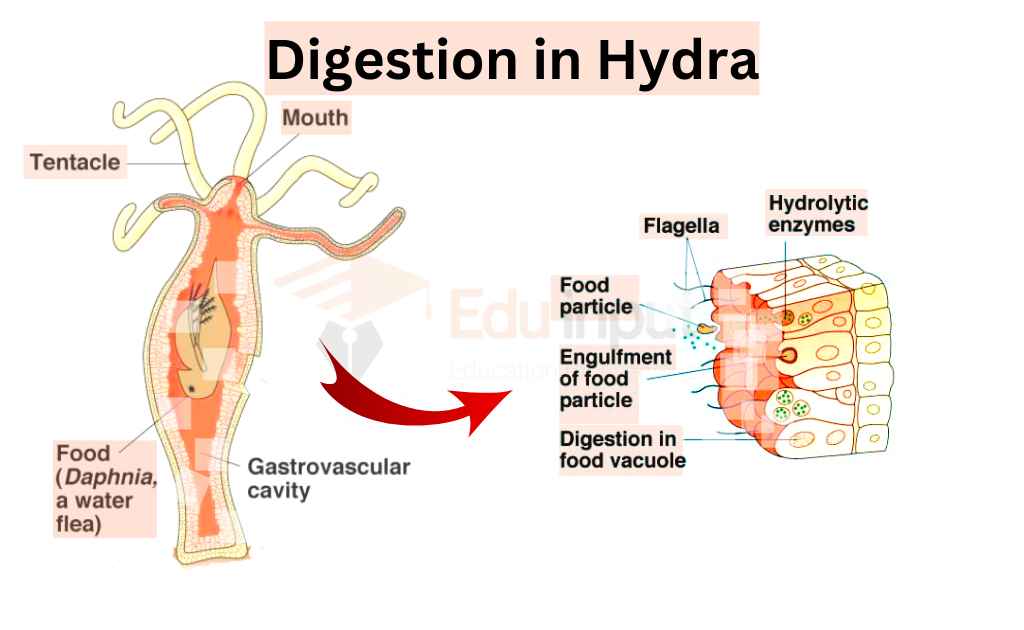Animal Strategies For Getting And Using Food
Animals use different strategies to get and use food. Herbivores eat plants for energy, while carnivores prey on other animals. Omnivores, such as humans, have a mixed diet. They consume both plants and animals.

Some animals, like grazers, consume large quantities of low-nutrient food and have adaptations to extract energy efficiently. These strategies help animals to get required energy and nutritional requirements for survival.
| Key Points |
|---|
| 1. Animals have different strategies for obtaining and using food, including herbivory, carnivory, and omnivory. 2. Animals can be continuous or discontinuous feeders, depending on their feeding behavior and digestive system. 3. Suspension feeders capture and consume food particles suspended in water through specialized feeding structures. 4. Deposit feeders obtain nutrients from sediments or soils by swallowing large quantities of organic matter and digesting the usable nutrients. 5. Herbivores consume macroscopic plants and have adaptations for biting, chewing, and digesting plant matter. 6. Scavengers feed on organic waste, such as carcasses, leaf litter, and manure, contributing to ecosystem balance and nutrient recycling. 7 Predators capture and kill live prey using various methods, such as active pursuit, waiting in ambush, or opportunistic feeding. 8. Some animals, such as free-living protozoa, have the ability to directly absorb nutrients through their body surface from the external environment. |
Mode of Nutrition in Animals
Nutrition is the process of obtaining food and then using it for obtaining energy, growth, and repair of the body. Animals are divided into three groups on the basis of their food habits: Herbivores, Carnivores, and Omnivores. The five main processes concerned with the use of food by animals are Ingestion, Digestion, Absorption, Assimilation, and Ingestion.
Only a few protists and animals can absorb food directly from the external environment. Most animals work for their nutrients. Different animals have different adaptations for digestion and absorption of food.
Animal Strategies For Getting Food
Animals have two main strategies for obtaining food:
1. Continuous and Discontinuous Feeders
Different animals may be continuous or discontinuous feeders. They also have a different structure of digestive systems.
Continuous Feeder
Continuous feeders are also known as filter feeders. They are slow-moving or sedentary. They constantly extract food by filtering water or air to capture small particles, such as plankton or nutrients. Examples of continuous feeders include baleen whales.
For example, aquatic suspension feeders like tube worms and barnacles. They remain in one place and continuously “strain” small food particles from the water.
Discontinuous Feeders
Discontinuous feeders are active and mobile animals. They actively search for and capture their prey, usually in discrete hunting events. Carnivores like lions or cheetahs are examples of discontinuous feeders.
They have specializations in the digestive system. Discontinuous feeders take in large meals. It is ground up and stored.
For example, many carnivores follow and capture large prey. Carnivores and herbivores have different digestive systems that allow them to digest their food differently.
Carnivores have digestive systems that can store food and digest it gradually, while herbivores have digestive systems that gather food quickly but digest it gradually. This difference in how they digest their food affects how often they need to eat. Carnivores only need to eat infrequently because they can store their food and digest it slowly, while herbivores need to eat more often because they gather their food quickly and digest it slowly.
2. Suspension Feeders
The removal of suspended food particles from the surrounding water by capturing trapping or filtration is called suspension feeding.
Suspension feeders have the ability to capture and consume food particles suspended in water. This group of organisms ranges from sponges to birds. They possess the shared ability to extract and obtain nourishment from these suspended food particles.
It has three steps:
1. Transport of water through the feeding structure.
2. Removal of nutrients (from the water).
3. Transport of the nutrients to the mouth of the digestive system.

Examples:
Sponges, ascidians, branchiopods, ectoprocts, entoprocts, phoronids, most bivalves, and many crustaceans, polychaete, gastropods, and some nonvertebrate chordates are suspension feeders.
3. Deposit Feeders
The obtaining of nutrients from the sediments of soft-bottom habitats (mud and sands) or terrestrial soils is called deposit feeding. Deposit feeding is present in primarily omnivorous animals. These animals simply swallow large quantities of sediment (mud, soil, sand, organic matter). The usable nutrients are digested.
The remaining material is passed out of the anus. Direct deposit feeding occurs in many polychaete annelids, some snails, some sea urchins, and most earthworms. Other direct deposit feeders use tentacle-like structures. Its examples are sea cucumbers, most sipunculans, certain clams, and several types of polychaete.
4. Herbivory
The consumption of macroscopic plants is called herbivory. It is a common feeding strategy. It requires the ability to “bite and chew” large pieces of plant matter (macroherbivory). The herbivores develop some hard surfaces like teeth.
Powerful muscles move these teeth. Herbivory is also present in some vertebrates like mollusks, polychaete worms, arthropods, and sea urchins.
5. Scavenging
Animals that feeds on organic waste like manure (dung beetles, flies), leaf litter (snails, millipedes, earthworms), and carcasses (blowflies, vultures, hyenas, storks) are called scavengers.

Examples like coyotes, jackals, ravens, and others help maintain the balance in ecosystems by efficiently removing and recycling decaying matter. The presence of these scavengers is crucial for a healthier environment.
6. Predation
The capturing and killing of prey for obtaining food is called predation. It is the most sophisticated feeding strategy. It requires capturing live prey. Predators can be classified on the basis of methods of capturing their prey. These are motile stalkers, lurking predators, sessile opportunists, or grazers.
1. Motile stalkers: They actively pursue their prey.
2. Lurking predators: They sit and wait for their prey to come within seizing distance.
3. Sessile opportunists: They are not very mobile. They can only capture prey when the prey organism comes into contact with them.
4. Grazing carnivores: They move about the substrate and pick up small organisms. Their diet consists of sessile and slow-moving animals.
7. Surface Nutrient Absorption
These animals directly absorb nutrients through their body surface from the external medium. This medium may be nutrient-rich seawater, fluid in the digestive tracts of another animal, or the body fluid of other animals.
Surface nutrient absorption is present in some highly specialized animals. These animals have discarded all the mechanisms for capturing prey, ingestion of food particles, and digestive. Its examples is free-living protozoa.
FAQs
What are the feeding strategies of animals?
Animals have various feeding strategies, including
1. Herbivory (eating plants)
2. Carnivory (eating meat)
3. Omnivory (eating both plants and animals)
4. Insectivory (eating insects)
5. Filter-feeding (extracting food particles from water)
6. Scavenging (eating dead animals)
7. Symbiotic feeding (mutualistic relationships for food)
What are the feeding strategies for mammals?
Following feeding strategies are observed in mammals:
1. Herbivory (Consuming plant material)
2. Carnivory (Feeding on other animals)
3. Omnivory (Consuming both plant and animal matter)
4. Insectivory (Specializing in eating insects and other invertebrates)
5. Piscivory (Predominantly feeding on fish)
6. Frugivory (Relying on fruits as the main food source)
7. Nectarivory (Feeding on nectar from flowers)
8. Folivory (Specializing in eating leaves)
What are the main feeding mechanisms of animals?
The four main feeding mechanisms of animals are:
1. Herbivory: Feeding on plant material.
2. Carnivory: Feeding on other animals
3. Omnivory: Feeding on both plant and animal matter.
4. Filter-feeding: Straining small organisms or food particles from the surrounding medium.
5. Bulk-feeding: Eating relatively large pieces of food.
6. Fluid-feeding: Sucking nutrient-rich fluid from a living host.
7. Substrate-feeding: Animals that live on their food source.
What is the feeding behavior of animals?
Feeding behavior refers to how animals obtain the food they need to survive. Different animals have different ways of getting their nutrients because they eat different types of food. Just like our bodies need food to function, the cells in an animal’s body also need a constant supply of nutrients to stay alive and healthy. Animals have developed various methods to find and consume food based on the types of foods they eat and the adaptations they have.





Leave a Reply